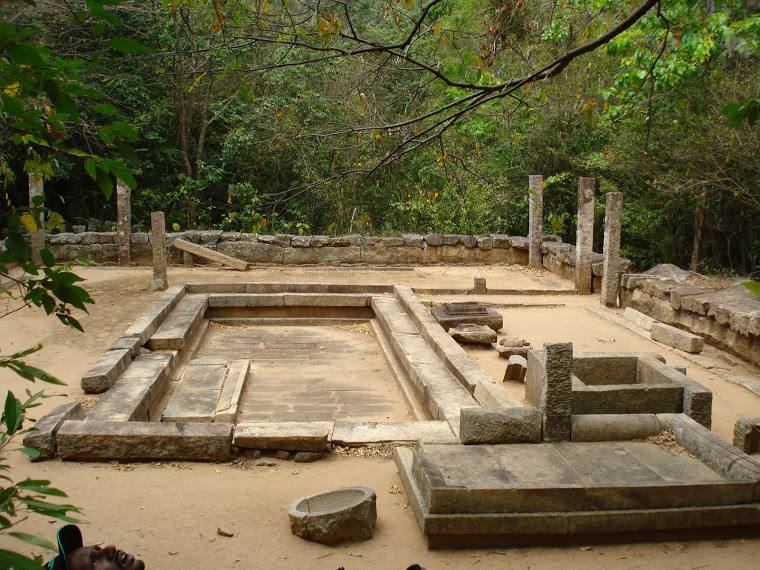Padhanaghara; Jain Distortion

By Ama H.Vanniarachchy
“Confidence is ignorance. If you’re feeling cocky, it’s because there’s something you don’t know.”
-Eoin Colfer, Artemis Fowl
Distortion or misinterpretations of Sri Lankan history is a recent trend. This is indeed sad and at the same time dangerous in many aspects. One reason is that these misinterpretations alter the country’s known and accepted history and at the same time such misinterpretations do not tally with widely accepted academic theories in the discipline of heritage studies, cultural studies, history, and archaeology. One cannot present interpretations within the said disciplines without abiding by accepted theories and practices, merely based on personal agendas or preferences. A trained professional scholar would not do so.
Among many such misinterpretations of Sri Lankan heritage are stories of distorted history and bizarre interpretations of art and architectural monuments. Such bizarre interpretations are not supported with evidence, nor analysed or approached following any theories or methodologies. To name a few are; Lion’s paw at Sigiriya (a certain group claims that it is the claws of a bird), one of the Sigiriya fresco figures (some claim that this figure represents a mythical queen called Mandodari), Hiriwadunna as the birthplace of Prince Siddhartha, etc. There are also certain distorted stories about the pre-Buddhist history of the island as some attempt to tell stories about mythical tribes and groups that are only mentioned in a few chronicles but not yet proven.
Another disastrous and absurd interpretation that caught our attention recently was published on a foreign website and at an international conference organized by a certain religious group claiming that the Buddhist architectural feature known as Padhanaghara are Jain temples, and the elegantly carved urinal stones found at these Buddhist monasteries are Jain veneration stones. However, fortunately, or unfortunately this is not widely known in Sri Lanka but is widely ‘misused’ overseas.
Hence today, the Ceylon Today Heritage page will focus on this matter and would like to bring this to the attention of senior academics.
What is a Padhanaghara
According to Professor Senerath Paranavithana, padhanaghara are a special type of buildings utilized by Buddhist monks for meditation purposes.
Padhanaghara is a special architectural feature that can be seen within Buddhist monasteries in Sri Lanka, says Professor T.G.Kulatunga, an expert in Buddhist arts and architecture and Buddhist history. He was a university professor, the director of the Abhayagiriya project of the UNESCO CCF project, and an eminent scholar who has authored a number of highly acclaimed books and research papers.
Prof. Kulatunga said that there have been padhanaghara built within larger monasteries such as Mahavihara and Abayagiriya. Mahavamsa (composed in the 5th century AD) states that Buddhagosha thero first met the chief monk of the Mahavihara monastery at the Padhanaghara of the Mahavihara monastery, said the professor.
Explaining the etymology of the term, Prof. Kulatunga said that as mentioned in the Saddharmalankaraya, pathana bhumiya means the land or the place where a yogi or an ascetic destroys sins courageously and leads an ascetic life.
Professor Kulatunga said that padhanaghara is the pali term used for piyangal vihara. Padhanashala is another term referred to padhanaghara in the Mahavamsa. Piyangal vihara is the Sinhala term for padhanaghara. The term piyangal vehera is used in Anuradhapura period inscriptions.
According to Prof. Paranavitana, padhanaghara is a word that can be seen in inscriptions that refer to the term padhanashala. He further explains that padhanashala is the pali term and padanahala is the Sinhala term.
Dr.Gamini Wijesuriya (Special Advisor to the Director-General of ICCROM, Rome, Italy; and Special Advisor to the Director of WHITRAP Shanghai, China) who’s PhD thesis is titled as Buddhist Meditation Monasteries of Ancient Sri Lanka explained to us that padhanaghara can be identified as a residential building type within Buddhist monasteries.
“The term padhanaghara as a designation to identify the architecture being studied was first used by Paranavitana. In 1957, in an article on Sri Lankan Architecture, he distinguished the double-platform building among other types”, said Dr. Wijesuriya.
Dr. Wijesuriya enlightened us that Prof.Paranavitana called them meditation houses: ‘Meditation houses of this type are also found at a number of other places, for instance, at Ritigala, Manakanda, and Arankale.
Prof. Paranvithana writes, “Many arannavasins no doubt lived in caves or huts of an ephemeral nature which have left no traces, but the padhanagharas (piyangal in Sinhalese) meant as abodes of meditating bhikkhus who were considered to be of particular holiness had been built with such a lavish expenditure of labor and wealth, that their remains have been taken as those of palaces not only by the unlettered villagers but also by some antiquaries.”
Dr. Wijesuriya said that the word padhanaghara can be construed as a combination of Pali padhana and ghara meaning house of meditation. The Vimativinodini, a sub-commentary of the Samantapasadika explains in explicit terms that the padhanaghara is a dwelling suitable for a yogavacara, who meditates with effort. This lends added support to the identification of padhanaghara as a place of meditation.
He further explained that the references to the Mahavamsa and Culavamsa suggest that some padhanagharas were associated with ascetic monks who were devoted to meditation. The grants of villages and tanks mentioned suggest that they were self-supporting monastic establishments, just like any other monastery. Therefore, it may be argued that by extension the word padhanaghara could be used to denote a monastery.
Identifying the Sudassana Padhanagahara with the aid of Perimiyankulama inscription
Prof. Kulatunga who was the director of the Abayagiriya project said that 11 caves with drip ledges and a padhanaghara used by the forest-dwelling monks were discovered on the Dighapashana to the northwest of the Abhayagiri site. This is identified as the Sudassana padhanaghara built by King Vasabha (67–111 AD), with the aid of the inscription known as the perimiankulama inscription that clearly mentions the name Sudassana.
Prof.Kulatunga further said that, as stated in the Mahavamsa, Buddhaghosha came to the Mahavihara in the 5th century AD and met Sanghapala thero, the chief of Mahavihara monastery, at the Mahavihara padhanaghara. Buddhagosha thera in his colophon to the Samanthapasadika stated that he wrote it while staying at the temple constructed by Mahanigama sami of the padhanaghara situated on the right side of the Mahavihara.
Can Padhanaghara monasteries be dated to the pre-Buddhist period of Sri Lanka?
Answering our question, Prof. Kulatunga said that all the padhanaghara found in Sri Lanka, can be dated to the post-5th century era, based on their arts and architecture.
The oldest known padhanaghara in Sri Lanka is the one at Veherabandi gala. Although archaeologist Hocart dated this to the 3-4th century AD, eminent scholar and senior archaeologist Prof. Senaka Bandaranayake, dates Veherabandigala or Kiralagala padhanaghara to the 5-6th century and clarifies this as the oldest padhanaghara to be identified in Sri Lanka. According to Prof. Bandaranayake, no padhanaghara in Sri Lanka can be dated prior to the period of 1st century BC.
The most well-known padhanaghara is the one at Anuradhapura, popularly known as the Western monasteries. This is dated to the 9-10 century AD.
Was there a Jain monastery at Abayagiriya, prior to King Valagamba (103 BC and c. 89–77 BC)?
The Sudassana monastery at Abayagiriya could be older than the time of Valagamba (103 BC and c. 89–77 BC), which means there was a Buddhist hermitage even before the king built the great stupa, explained Prof. Kulatunga.
Professor Kulatunga explained to us that the perimiyankulama inscription proves that the name of this monastery is Sudassana Padhanaghara during the time of King Vasabha (67–111 AD). There is a story in Rasavahini about a Buddhist monk who resided in the Sudassana padhanaghara walking in the village begging for alms. This was witnessed by a minister of King Saddhathissa. As the name of the place is mentioned as Sudassana the description also gives the location of the place. Based on that description in Rasavahini and the inscription, archaeologists believe that the Sudassana monastery existed during the time of Saddhathissa (137 BC to 119 BC).
Professor Kulatunga further said that during the extensive archaeological excavations conducted at the site, no archaeological remains of a Jain monastery were found at Abayagiriya. He further said that these are architectural structures that are unique to Buddhist architecture in Sri Lanka and cannot be seen elsewhere in the Buddhist world. The only similar structure to a padhanaghara can be seen in Java, at Ratubaka plateau. These are the remains of a Buddhist monastery. Interestingly, an inscription at this place revealed that the monastery was an establishment of the ‘Abhayagiri vihara of Sinhalese monks trained in the sayings of the Buddhas’. This inscription is dated to the 8th century AD. Commenting on this record, J.G. de Casparis says, ‘The most important detail is the name of the foundation, the Abhayagiri Vihara’.
Prof. Kulatunga said that this proves that the architectural structure, padhanaghara, is unique to Sri Lankan Buddhist architecture.
This means, that if these monasteries are to be Jain temples as some may claim, there should be ruins of Jain temples in India or elsewhere, parallel to the same time period, of similar architectural style.
Why are there no decorations and Buddhist objects of veneration such as stupas, bodhigharas, or images?
Answering our question, Prof. Kulatunga said that there were two main sects of Buddhist monks in Sri Lanka during early times. They were the Vidarshanadhura and the Granthadhura sects. Vidharshanadhura monks were focused on meditation and eliminating sins and worldly desires. They were not engaged in interacting with the lay. In contrast, the Granthadhura monks were focused on spreading the message of the Buddha hence they were involved in writing Buddhist texts, preaching to the lay, and showing the lay the path of Dhamma. Thus, the monasteries of Granthadhura monks were attractive, decorative, and had objects of veneration.
The monasteries of Vidarshanadhura monks were completely free of decorative or veneration objects.
The elegantly carved urinal stones
What is notable at these padhanaghara are the elegantly carved urinal and lavatory stones in the toilets. Former archaeology commissioner Godakumbure explains that these urinal stones could have been parts of some other building, removed from their original place and later fixed at these buildings.
However, some scholars say that these beautifully carved urinal stones have a deeper philosophy. These carvings represent wealth and worldly pleasures or desires. The Buddhist monks who practice meditation in these monasteries let go of worldly desires as unimportant and useless; hence they are carved in the toilets.
How to identify a padhanaghara
Prof. Paranavithana writes; “A class of monastic edifice which was developed to a high degree of perfection in the later Anuradhapura period was the padhanaghara, or meditation house, which must have had its origin in the humble hut of the ascetic, perched on a rock in the forest, and surrounded by a moat to ward off wild beasts.”
The distinguishing feature of a padhanaghara is that they are simple in style. There are no carvings or designs. The building is designed suitable for panshukulika monks who practice meditation. There is a similar plan that has been followed by all padhanaghara found everywhere in Sri Lanka. There are two raised platforms built on a rock outcrop which is surrounded by a moat. One can see stone bridges and stairways that connect these platforms with each other.
Padhanaghara monasteries in Sri Lanka
Veherabandigala, Ritigala, Manakanda, Arankale, Nuwaragala kanda, Nagolla, Budugala, Seeta kotuwa
“Without education, we are in a horrible and deadly danger of taking educated people seriously.”
– G.K. Chesterton
Tantitimale Padhanaghara
Western Monasteries, Anuradhapura
Arankale Padhanaghara
Uncategorized, Jain architecture, Padhanaghara, Sri Lankan archaeology, SRI LANKAN HISTORY
